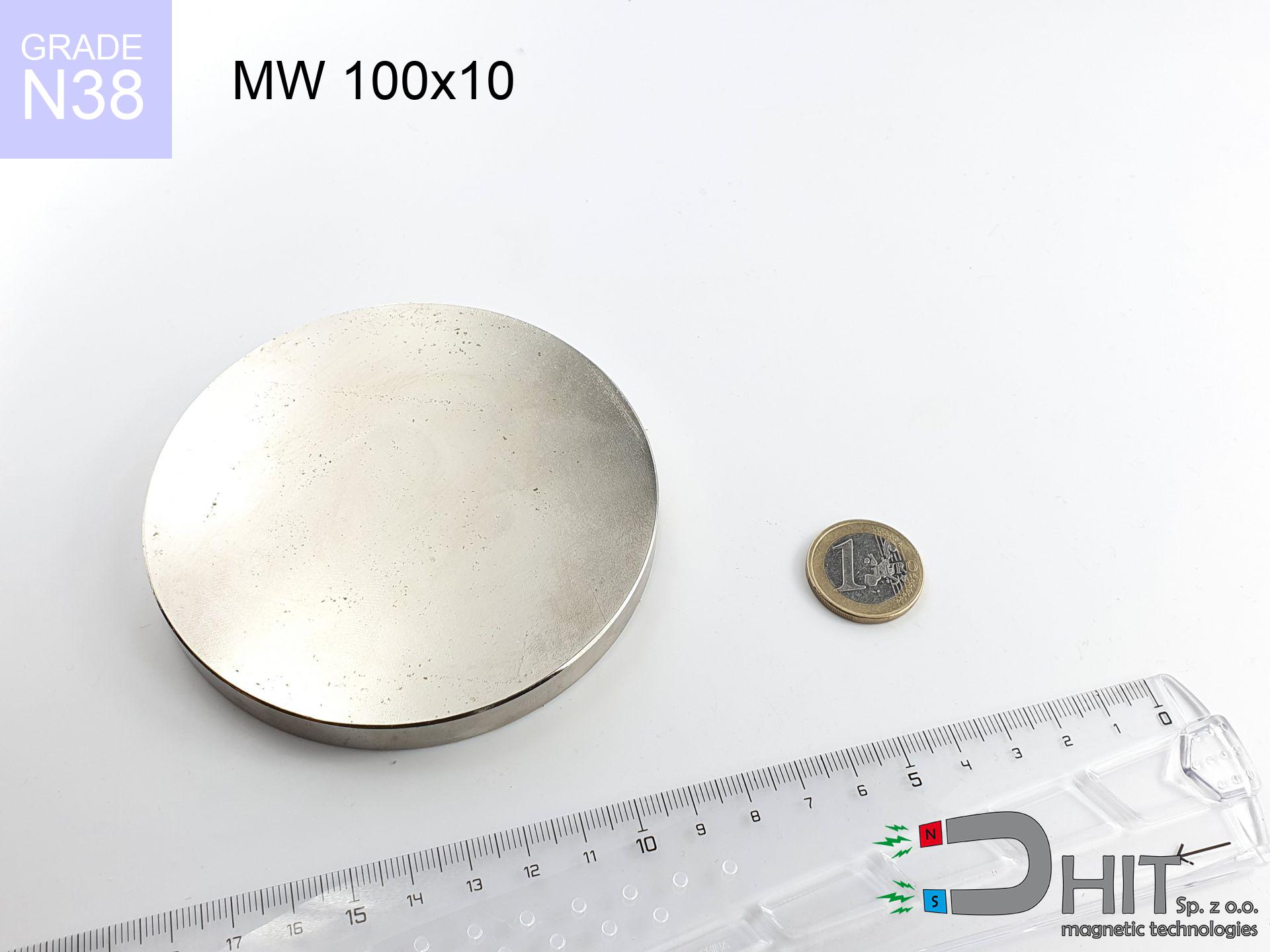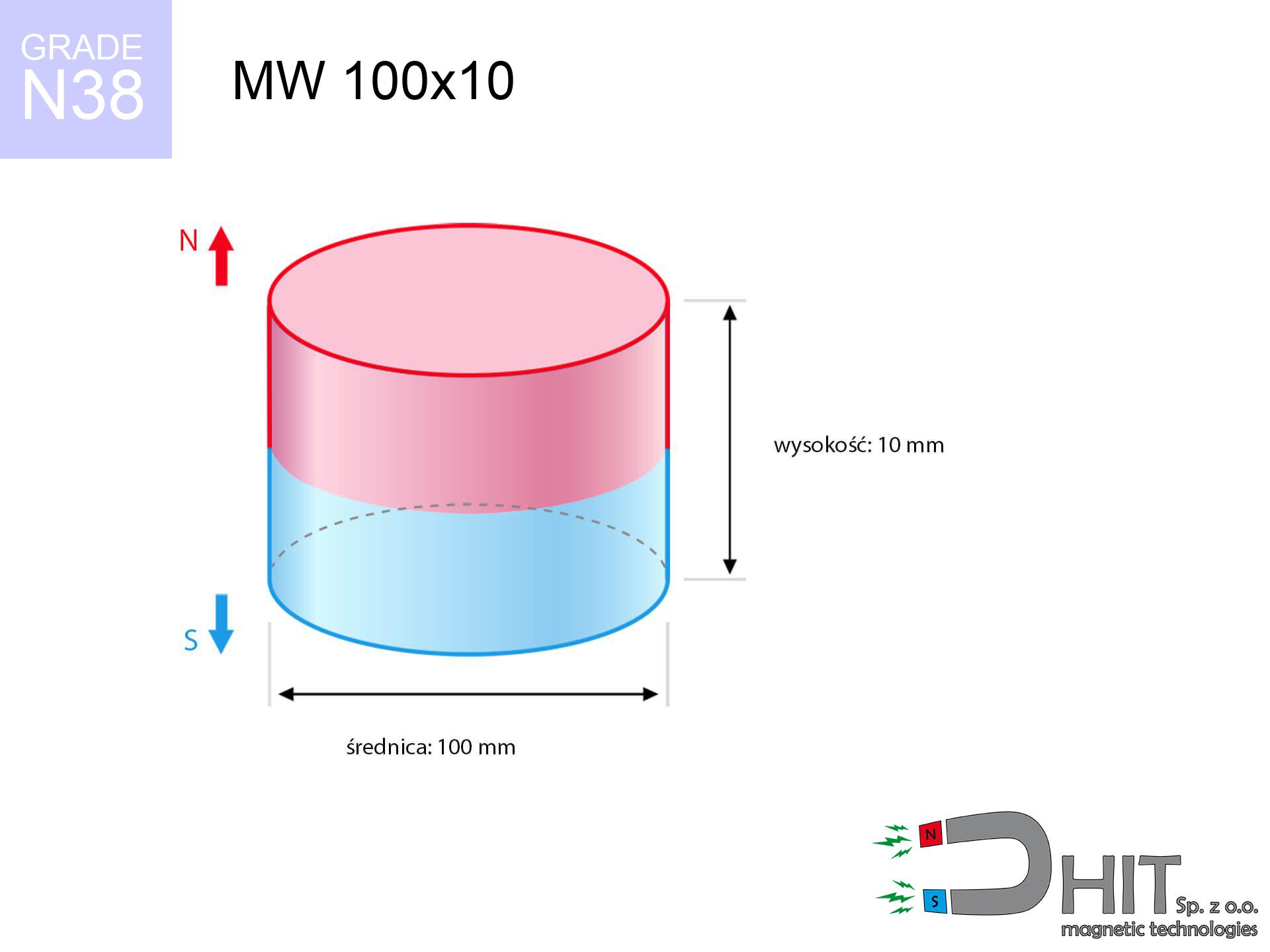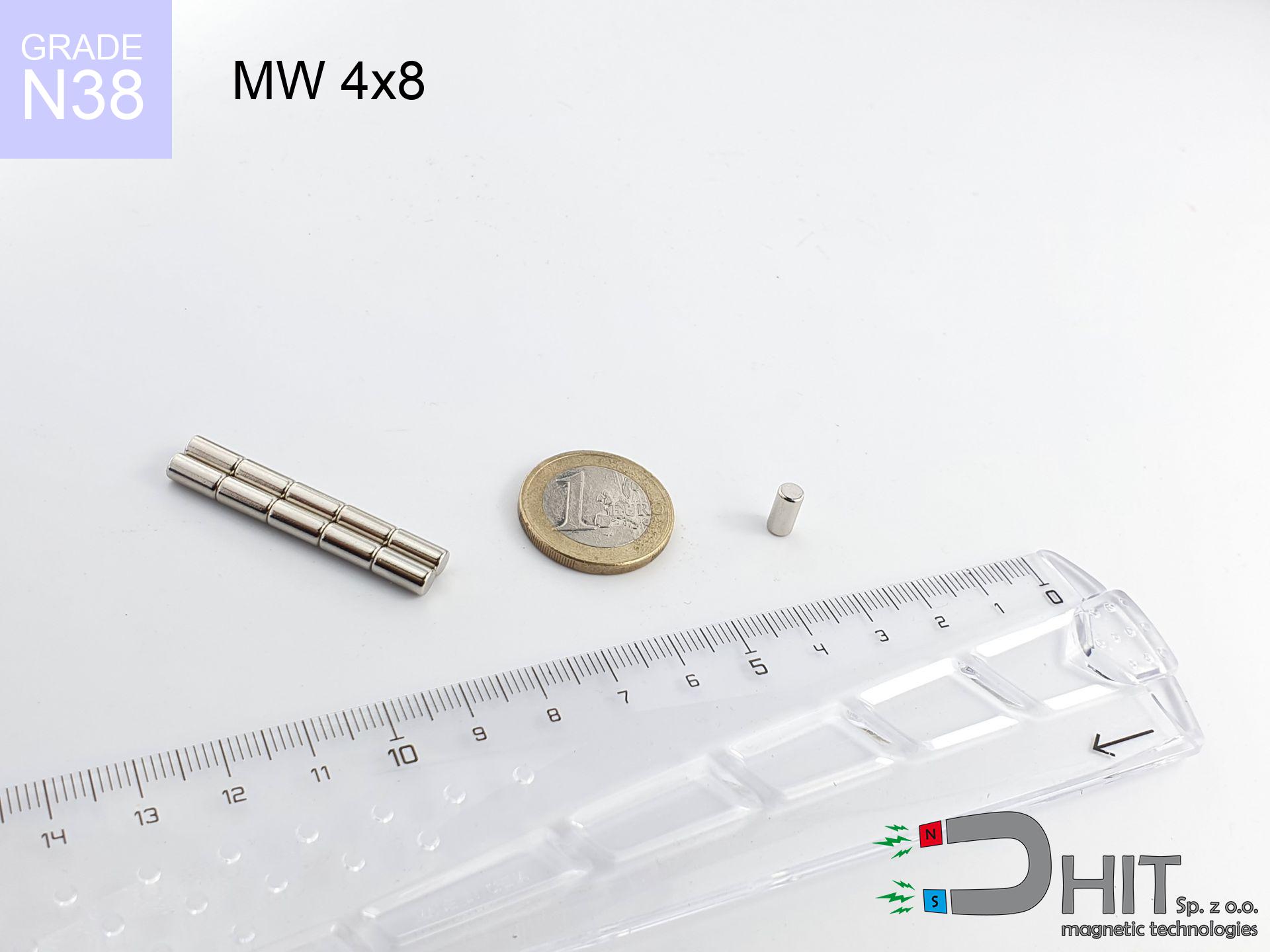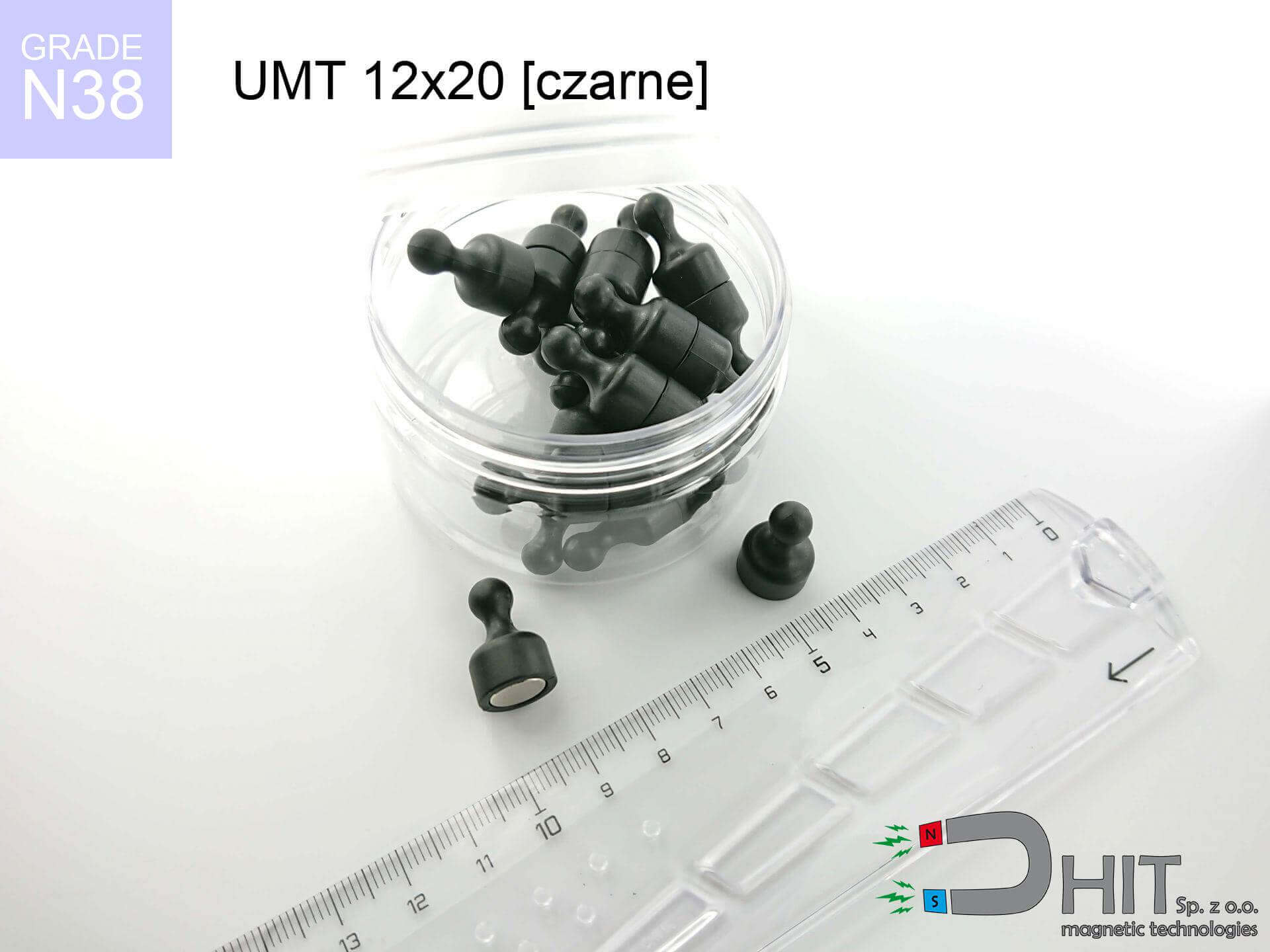MW 100x10 / N38 - cylindrical magnet
cylindrical magnet
Catalog no 010001
GTIN/EAN: 5906301810018
Diameter Ø
100 mm [±0,1 mm]
Height
10 mm [±0,1 mm]
Weight
589.05 g
Magnetization Direction
↑ axial
Load capacity
40.86 kg / 400.80 N
Magnetic Induction
121.59 mT / 1216 Gs
Coating
[NiCuNi] Nickel
368.50 ZŁ with VAT / pcs + price for transport
299.59 ZŁ net + 23% VAT / pcs
bulk discounts:
Need more?
Call us
+48 888 99 98 98
alternatively get in touch using
form
through our site.
Force and form of magnets can be verified with our
force calculator.
Orders placed before 14:00 will be shipped the same business day.
Technical data - MW 100x10 / N38 - cylindrical magnet
Specification / characteristics - MW 100x10 / N38 - cylindrical magnet
| properties | values |
|---|---|
| Cat. no. | 010001 |
| GTIN/EAN | 5906301810018 |
| Production/Distribution | Dhit sp. z o.o. |
| Country of origin | Poland / China / Germany |
| Customs code | 85059029 |
| Diameter Ø | 100 mm [±0,1 mm] |
| Height | 10 mm [±0,1 mm] |
| Weight | 589.05 g |
| Magnetization Direction | ↑ axial |
| Load capacity ~ ? | 40.86 kg / 400.80 N |
| Magnetic Induction ~ ? | 121.59 mT / 1216 Gs |
| Coating | [NiCuNi] Nickel |
| Manufacturing Tolerance | ±0.1 mm |
Magnetic properties of material N38
| properties | values | units |
|---|---|---|
| remenance Br [min. - max.] ? | 12.2-12.6 | kGs |
| remenance Br [min. - max.] ? | 1220-1260 | mT |
| coercivity bHc ? | 10.8-11.5 | kOe |
| coercivity bHc ? | 860-915 | kA/m |
| actual internal force iHc | ≥ 12 | kOe |
| actual internal force iHc | ≥ 955 | kA/m |
| energy density [min. - max.] ? | 36-38 | BH max MGOe |
| energy density [min. - max.] ? | 287-303 | BH max KJ/m |
| max. temperature ? | ≤ 80 | °C |
Physical properties of sintered neodymium magnets Nd2Fe14B at 20°C
| properties | values | units |
|---|---|---|
| Vickers hardness | ≥550 | Hv |
| Density | ≥7.4 | g/cm3 |
| Curie Temperature TC | 312 - 380 | °C |
| Curie Temperature TF | 593 - 716 | °F |
| Specific resistance | 150 | μΩ⋅cm |
| Bending strength | 250 | MPa |
| Compressive strength | 1000~1100 | MPa |
| Thermal expansion parallel (∥) to orientation (M) | (3-4) x 10-6 | °C-1 |
| Thermal expansion perpendicular (⊥) to orientation (M) | -(1-3) x 10-6 | °C-1 |
| Young's modulus | 1.7 x 104 | kg/mm² |
Physical simulation of the magnet - technical parameters
The following information are the outcome of a mathematical calculation. Values were calculated on algorithms for the material Nd2Fe14B. Actual conditions might slightly differ from theoretical values. Use these calculations as a preliminary roadmap when designing systems.
Table 1: Static force (pull vs gap) - interaction chart
MW 100x10 / N38
| Distance (mm) | Induction (Gauss) / mT | Pull Force (kg/lbs/g/N) | Risk Status |
|---|---|---|---|
| 0 mm |
1216 Gs
121.6 mT
|
40.86 kg / 90.08 LBS
40860.0 g / 400.8 N
|
critical level |
| 1 mm |
1208 Gs
120.8 mT
|
40.35 kg / 88.95 LBS
40345.4 g / 395.8 N
|
critical level |
| 2 mm |
1199 Gs
119.9 mT
|
39.74 kg / 87.62 LBS
39742.7 g / 389.9 N
|
critical level |
| 3 mm |
1189 Gs
118.9 mT
|
39.06 kg / 86.12 LBS
39062.0 g / 383.2 N
|
critical level |
| 5 mm |
1165 Gs
116.5 mT
|
37.49 kg / 82.65 LBS
37490.2 g / 367.8 N
|
critical level |
| 10 mm |
1087 Gs
108.7 mT
|
32.64 kg / 71.96 LBS
32640.7 g / 320.2 N
|
critical level |
| 15 mm |
991 Gs
99.1 mT
|
27.15 kg / 59.86 LBS
27153.9 g / 266.4 N
|
critical level |
| 20 mm |
887 Gs
88.7 mT
|
21.76 kg / 47.97 LBS
21758.7 g / 213.5 N
|
critical level |
| 30 mm |
683 Gs
68.3 mT
|
12.90 kg / 28.45 LBS
12902.7 g / 126.6 N
|
critical level |
| 50 mm |
379 Gs
37.9 mT
|
3.97 kg / 8.75 LBS
3968.4 g / 38.9 N
|
warning |
Table 2: Vertical load (vertical surface)
MW 100x10 / N38
| Distance (mm) | Friction coefficient | Pull Force (kg/lbs/g/N) |
|---|---|---|
| 0 mm | Stal (~0.2) |
8.17 kg / 18.02 LBS
8172.0 g / 80.2 N
|
| 1 mm | Stal (~0.2) |
8.07 kg / 17.79 LBS
8070.0 g / 79.2 N
|
| 2 mm | Stal (~0.2) |
7.95 kg / 17.52 LBS
7948.0 g / 78.0 N
|
| 3 mm | Stal (~0.2) |
7.81 kg / 17.22 LBS
7812.0 g / 76.6 N
|
| 5 mm | Stal (~0.2) |
7.50 kg / 16.53 LBS
7498.0 g / 73.6 N
|
| 10 mm | Stal (~0.2) |
6.53 kg / 14.39 LBS
6528.0 g / 64.0 N
|
| 15 mm | Stal (~0.2) |
5.43 kg / 11.97 LBS
5430.0 g / 53.3 N
|
| 20 mm | Stal (~0.2) |
4.35 kg / 9.59 LBS
4352.0 g / 42.7 N
|
| 30 mm | Stal (~0.2) |
2.58 kg / 5.69 LBS
2580.0 g / 25.3 N
|
| 50 mm | Stal (~0.2) |
0.79 kg / 1.75 LBS
794.0 g / 7.8 N
|
Table 3: Wall mounting (shearing) - behavior on slippery surfaces
MW 100x10 / N38
| Surface type | Friction coefficient / % Mocy | Max load (kg/lbs/g/N) |
|---|---|---|
| Raw steel |
µ = 0.3
30% Nominalnej Siły
|
12.26 kg / 27.02 LBS
12258.0 g / 120.3 N
|
| Painted steel (standard) |
µ = 0.2
20% Nominalnej Siły
|
8.17 kg / 18.02 LBS
8172.0 g / 80.2 N
|
| Oily/slippery steel |
µ = 0.1
10% Nominalnej Siły
|
4.09 kg / 9.01 LBS
4086.0 g / 40.1 N
|
| Magnet with anti-slip rubber |
µ = 0.5
50% Nominalnej Siły
|
20.43 kg / 45.04 LBS
20430.0 g / 200.4 N
|
Table 4: Material efficiency (saturation) - power losses
MW 100x10 / N38
| Steel thickness (mm) | % power | Real pull force (kg/lbs/g/N) |
|---|---|---|
| 0.5 mm |
|
2.04 kg / 4.50 LBS
2043.0 g / 20.0 N
|
| 1 mm |
|
5.11 kg / 11.26 LBS
5107.5 g / 50.1 N
|
| 2 mm |
|
10.22 kg / 22.52 LBS
10215.0 g / 100.2 N
|
| 3 mm |
|
15.32 kg / 33.78 LBS
15322.5 g / 150.3 N
|
| 5 mm |
|
25.54 kg / 56.30 LBS
25537.5 g / 250.5 N
|
| 10 mm |
|
40.86 kg / 90.08 LBS
40860.0 g / 400.8 N
|
| 11 mm |
|
40.86 kg / 90.08 LBS
40860.0 g / 400.8 N
|
| 12 mm |
|
40.86 kg / 90.08 LBS
40860.0 g / 400.8 N
|
Table 5: Working in heat (material behavior) - resistance threshold
MW 100x10 / N38
| Ambient temp. (°C) | Power loss | Remaining pull (kg/lbs/g/N) | Status |
|---|---|---|---|
| 20 °C | 0.0% |
40.86 kg / 90.08 LBS
40860.0 g / 400.8 N
|
OK |
| 40 °C | -2.2% |
39.96 kg / 88.10 LBS
39961.1 g / 392.0 N
|
OK |
| 60 °C | -4.4% |
39.06 kg / 86.12 LBS
39062.2 g / 383.2 N
|
|
| 80 °C | -6.6% |
38.16 kg / 84.14 LBS
38163.2 g / 374.4 N
|
|
| 100 °C | -28.8% |
29.09 kg / 64.14 LBS
29092.3 g / 285.4 N
|
Table 6: Two magnets (attraction) - field collision
MW 100x10 / N38
| Gap (mm) | Attraction (kg/lbs) (N-S) | Sliding Force (kg/lbs/g/N) | Repulsion (kg/lbs) (N-N) |
|---|---|---|---|
| 0 mm |
71.58 kg / 157.80 LBS
2 302 Gs
|
10.74 kg / 23.67 LBS
10737 g / 105.3 N
|
N/A |
| 1 mm |
71.15 kg / 156.86 LBS
2 424 Gs
|
10.67 kg / 23.53 LBS
10673 g / 104.7 N
|
64.04 kg / 141.17 LBS
~0 Gs
|
| 2 mm |
70.68 kg / 155.82 LBS
2 416 Gs
|
10.60 kg / 23.37 LBS
10602 g / 104.0 N
|
63.61 kg / 140.23 LBS
~0 Gs
|
| 3 mm |
70.17 kg / 154.69 LBS
2 408 Gs
|
10.53 kg / 23.20 LBS
10525 g / 103.3 N
|
63.15 kg / 139.22 LBS
~0 Gs
|
| 5 mm |
69.04 kg / 152.21 LBS
2 388 Gs
|
10.36 kg / 22.83 LBS
10356 g / 101.6 N
|
62.14 kg / 136.99 LBS
~0 Gs
|
| 10 mm |
65.68 kg / 144.79 LBS
2 329 Gs
|
9.85 kg / 21.72 LBS
9851 g / 96.6 N
|
59.11 kg / 130.31 LBS
~0 Gs
|
| 20 mm |
57.18 kg / 126.06 LBS
2 173 Gs
|
8.58 kg / 18.91 LBS
8577 g / 84.1 N
|
51.46 kg / 113.45 LBS
~0 Gs
|
| 50 mm |
29.67 kg / 65.40 LBS
1 565 Gs
|
4.45 kg / 9.81 LBS
4450 g / 43.7 N
|
26.70 kg / 58.86 LBS
~0 Gs
|
| 60 mm |
22.60 kg / 49.83 LBS
1 366 Gs
|
3.39 kg / 7.47 LBS
3390 g / 33.3 N
|
20.34 kg / 44.85 LBS
~0 Gs
|
| 70 mm |
16.98 kg / 37.43 LBS
1 184 Gs
|
2.55 kg / 5.61 LBS
2546 g / 25.0 N
|
15.28 kg / 33.68 LBS
~0 Gs
|
| 80 mm |
12.64 kg / 27.87 LBS
1 022 Gs
|
1.90 kg / 4.18 LBS
1896 g / 18.6 N
|
11.38 kg / 25.08 LBS
~0 Gs
|
| 90 mm |
9.38 kg / 20.67 LBS
880 Gs
|
1.41 kg / 3.10 LBS
1406 g / 13.8 N
|
8.44 kg / 18.60 LBS
~0 Gs
|
| 100 mm |
6.95 kg / 15.33 LBS
758 Gs
|
1.04 kg / 2.30 LBS
1043 g / 10.2 N
|
6.26 kg / 13.79 LBS
~0 Gs
|
Table 7: Safety (HSE) (implants) - precautionary measures
MW 100x10 / N38
| Object / Device | Limit (Gauss) / mT | Safe distance |
|---|---|---|
| Pacemaker | 5 Gs (0.5 mT) | 31.0 cm |
| Hearing aid | 10 Gs (1.0 mT) | 24.0 cm |
| Timepiece | 20 Gs (2.0 mT) | 19.0 cm |
| Phone / Smartphone | 40 Gs (4.0 mT) | 14.5 cm |
| Remote | 50 Gs (5.0 mT) | 13.5 cm |
| Payment card | 400 Gs (40.0 mT) | 5.0 cm |
| HDD hard drive | 600 Gs (60.0 mT) | 3.5 cm |
Table 8: Dynamics (kinetic energy) - collision effects
MW 100x10 / N38
| Start from (mm) | Speed (km/h) | Energy (J) | Predicted outcome |
|---|---|---|---|
| 10 mm |
11.87 km/h
(3.30 m/s)
|
3.20 J | |
| 30 mm |
17.18 km/h
(4.77 m/s)
|
6.71 J | |
| 50 mm |
19.89 km/h
(5.52 m/s)
|
8.99 J | |
| 100 mm |
26.67 km/h
(7.41 m/s)
|
16.17 J |
Table 9: Surface protection spec
MW 100x10 / N38
| Technical parameter | Value / Description |
|---|---|
| Coating type | [NiCuNi] Nickel |
| Layer structure | Nickel - Copper - Nickel |
| Layer thickness | 10-20 µm |
| Salt spray test (SST) ? | 24 h |
| Recommended environment | Indoors only (dry) |
Table 10: Electrical data (Flux)
MW 100x10 / N38
| Parameter | Value | SI Unit / Description |
|---|---|---|
| Magnetic Flux | 125 951 Mx | 1259.5 µWb |
| Pc Coefficient | 0.16 | Low (Flat) |
Table 11: Physics of underwater searching
MW 100x10 / N38
| Environment | Effective steel pull | Effect |
|---|---|---|
| Air (land) | 40.86 kg | Standard |
| Water (riverbed) |
46.78 kg
(+5.92 kg buoyancy gain)
|
+14.5% |
1. Vertical hold
*Caution: On a vertical surface, the magnet retains just a fraction of its max power.
2. Plate thickness effect
*Thin steel (e.g. computer case) drastically limits the holding force.
3. Thermal stability
*For standard magnets, the safety limit is 80°C.
4. Demagnetization curve and operating point (B-H)
chart generated for the permeance coefficient Pc (Permeance Coefficient) = 0.16
This simulation demonstrates the magnetic stability of the selected magnet under specific geometric conditions. The solid red line represents the demagnetization curve (material potential), while the dashed blue line is the load line based on the magnet's geometry. The Pc (Permeance Coefficient), also known as the load line slope, is a dimensionless value that describes the relationship between the magnet's shape and its magnetic stability. The intersection of these two lines (the black dot) is the operating point — it determines the actual magnetic flux density generated by the magnet in this specific configuration. A higher Pc value means the magnet is more 'slender' (tall relative to its area), resulting in a higher operating point and better resistance to irreversible demagnetization caused by external fields or temperature. A value of 0.42 is relatively low (typical for flat magnets), meaning the operating point is closer to the 'knee' of the curve — caution is advised when operating at temperatures near the maximum limit to avoid strength loss.
Material specification
| iron (Fe) | 64% – 68% |
| neodymium (Nd) | 29% – 32% |
| boron (B) | 1.1% – 1.2% |
| dysprosium (Dy) | 0.5% – 2.0% |
| coating (Ni-Cu-Ni) | < 0.05% |
Ecology and recycling (GPSR)
| recyclability (EoL) | 100% |
| recycled raw materials | ~10% (pre-cons) |
| carbon footprint | low / zredukowany |
| waste code (EWC) | 16 02 16 |
Other proposals
Advantages as well as disadvantages of Nd2Fe14B magnets.
Strengths
- They retain magnetic properties for around ten years – the drop is just ~1% (in theory),
- Magnets effectively protect themselves against demagnetization caused by foreign field sources,
- In other words, due to the aesthetic surface of gold, the element looks attractive,
- Neodymium magnets ensure maximum magnetic induction on a small area, which allows for strong attraction,
- Thanks to resistance to high temperature, they are able to function (depending on the form) even at temperatures up to 230°C and higher...
- Possibility of exact forming and optimizing to concrete applications,
- Key role in modern industrial fields – they find application in magnetic memories, drive modules, medical devices, also multitasking production systems.
- Relatively small size with high pulling force – neodymium magnets offer strong magnetic field in small dimensions, which allows their use in compact constructions
Limitations
- They are fragile upon too strong impacts. To avoid cracks, it is worth protecting magnets using a steel holder. Such protection not only shields the magnet but also increases its resistance to damage
- Neodymium magnets lose their power under the influence of heating. As soon as 80°C is exceeded, many of them start losing their force. Therefore, we recommend our special magnets marked [AH], which maintain durability even at temperatures up to 230°C
- Due to the susceptibility of magnets to corrosion in a humid environment, we recommend using waterproof magnets made of rubber, plastic or other material resistant to moisture, when using outdoors
- Limited ability of producing nuts in the magnet and complicated forms - recommended is cover - mounting mechanism.
- Potential hazard resulting from small fragments of magnets pose a threat, in case of ingestion, which becomes key in the aspect of protecting the youngest. Additionally, tiny parts of these magnets are able to disrupt the diagnostic process medical after entering the body.
- With mass production the cost of neodymium magnets is economically unviable,
Lifting parameters
Maximum lifting capacity of the magnet – what contributes to it?
- on a plate made of structural steel, optimally conducting the magnetic field
- whose thickness equals approx. 10 mm
- characterized by even structure
- under conditions of no distance (surface-to-surface)
- for force acting at a right angle (in the magnet axis)
- in neutral thermal conditions
What influences lifting capacity in practice
- Clearance – existence of foreign body (paint, tape, air) acts as an insulator, which lowers capacity rapidly (even by 50% at 0.5 mm).
- Force direction – remember that the magnet holds strongest perpendicularly. Under shear forces, the holding force drops drastically, often to levels of 20-30% of the nominal value.
- Steel thickness – too thin plate does not close the flux, causing part of the flux to be lost into the air.
- Steel type – mild steel attracts best. Higher carbon content reduce magnetic properties and lifting capacity.
- Surface condition – smooth surfaces ensure maximum contact, which improves field saturation. Uneven metal weaken the grip.
- Temperature – heating the magnet causes a temporary drop of induction. It is worth remembering the thermal limit for a given model.
Holding force was measured on a smooth steel plate of 20 mm thickness, when the force acted perpendicularly, in contrast under parallel forces the lifting capacity is smaller. Additionally, even a small distance between the magnet’s surface and the plate lowers the lifting capacity.
H&S for magnets
GPS and phone interference
Navigation devices and mobile phones are highly sensitive to magnetic fields. Direct contact with a powerful NdFeB magnet can permanently damage the internal compass in your phone.
Beware of splinters
Despite metallic appearance, neodymium is delicate and not impact-resistant. Do not hit, as the magnet may shatter into sharp, dangerous pieces.
Allergic reactions
It is widely known that nickel (standard magnet coating) is a potent allergen. If you have an allergy, prevent touching magnets with bare hands or select versions in plastic housing.
Do not give to children
Only for adults. Small elements pose a choking risk, causing serious injuries. Store out of reach of children and animals.
Immense force
Handle magnets with awareness. Their powerful strength can shock even experienced users. Plan your moves and respect their force.
Thermal limits
Avoid heat. Neodymium magnets are susceptible to heat. If you require resistance above 80°C, inquire about special high-temperature series (H, SH, UH).
Crushing risk
Protect your hands. Two powerful magnets will snap together immediately with a force of several hundred kilograms, destroying everything in their path. Be careful!
Dust is flammable
Drilling and cutting of neodymium magnets poses a fire risk. Neodymium dust reacts violently with oxygen and is difficult to extinguish.
Warning for heart patients
Health Alert: Neodymium magnets can turn off pacemakers and defibrillators. Do not approach if you have medical devices.
Electronic devices
Intense magnetic fields can erase data on credit cards, HDDs, and other magnetic media. Keep a distance of at least 10 cm.




![BM 950x180x70 [4x M8] - magnetic beam BM 950x180x70 [4x M8] - magnetic beam](https://cdn3.dhit.pl/graphics/products/bm-950x180x70-4x-m8-ves.jpg)

![MPL 40x10x4x2[7/3.5] / N38 - lamellar magnet MPL 40x10x4x2[7/3.5] / N38 - lamellar magnet](https://cdn3.dhit.pl/graphics/products/mpl40x10x4x27-3.5-suw.jpg)


